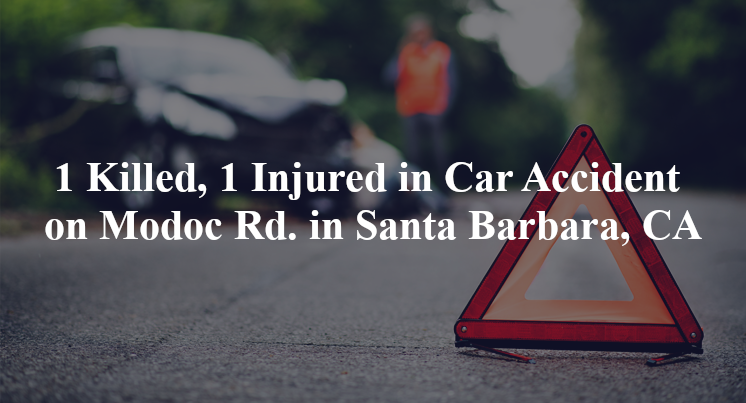1 Killed, 1 Injured in Car Accident on Modoc Rd. in Santa Barbara, CA
Santa Barbara, CA — April 15, 2025, One person was killed and two were injured in a car accident that occurred around 12:30 P.M. on Modoc Rd.

An investigation is underway following a car accident that left one person dead and two injured during the afternoon hours of April 15th. According to official reports, a GMC Terrain operated by a 19-year-old was traveling on Modoc Road in the eastbound lanes near Via Senda, when for unknown reasons the vehicle crossed into the westbound lanes where it struck an Audi A4 before the GMC then collided with a Toyota Camry.
When first responders arrived on the scene, they found that the driver of the Audi, an 84-year-old woman, and the GMC driver had sustained serious injuries and they were transported to the hospital, while the Toyota driver was minimally injured and denied medical transport. The GMC driver later succumbed to his injuries, and at this time there has been no further information released about the accident, including their identities, however this remains an ongoing investigation and more details may be released in the future.
Commentary
When a vehicle crosses into oncoming traffic, resulting in one fatality and multiple injuries, it’s tempting to assume the cause was simple—driver distraction, a moment of inattention, or poor decision-making. But those assumptions don’t serve the interests of truth or justice. In any serious crash, especially one that changes lives in an instant, there are three key questions that must be asked to ensure we understand exactly what happened and why.
First, we need to consider whether the authorities thoroughly investigated the crash. When a vehicle unexpectedly leaves its lane and collides with multiple others, it raises immediate concerns that warrant close examination. A proper investigation should involve reconstructing the sequence of impacts, documenting physical evidence from the scene, and identifying any external contributing factors such as roadway conditions or visibility issues. Given the age range and number of people involved, it's also essential that witness statements be collected carefully. Yet, in many cases, law enforcement agencies may lack the specialized training or resources to perform this level of detailed analysis—especially when time or staffing are limited. That’s why an independent review is sometimes the only way to ensure all possibilities are accounted for.
The second question is whether a vehicle defect could have contributed to the crash. A sudden and unexplained lane departure could signal a problem with the vehicle’s steering, suspension, brakes, or even electronic controls. While operator error is often presumed in these situations, mechanical failure is a real and frequently overlooked factor. The only way to explore this possibility is through a forensic examination of the vehicle before it is repaired or destroyed. Once the vehicle is gone, so is the opportunity to uncover whether a defect might have played a role. Too often, that step is never taken—either because no one thinks to ask or because access to the vehicle is lost too soon.
Lastly, it’s essential to ask whether all electronic data from the vehicles involved has been collected. Most modern vehicles are equipped with an Electronic Control Module (ECM), commonly referred to as a “black box,” which stores valuable data about speed, throttle position, braking activity, and steering input in the moments before a crash. That data can help confirm whether the vehicle responded to the driver’s commands—or failed to. Additionally, dash cam footage, nearby surveillance video, and cell phone records could all shed light on what was happening inside or around the vehicle at the time. But this kind of data doesn’t last forever; it must be secured quickly or it may be lost, overwritten, or corrupted.
When a crash results in the loss of life, those affected deserve more than assumptions. They deserve answers—clear, evidence-based, and rooted in facts. And the only way to get there is to ask the right questions, secure the critical evidence, and ensure nothing is overlooked in the search for the truth. That’s the responsibility we all share.

*We appreciate your feedback and welcome anyone to comment on our blog entries, however all visitor blog comments must be approved by the site moderator prior to showing live on the site. By submitting a blog comment you acknowledge that your post may appear live on the site for any visitors to see, pending moderator approval. The operators of this site are not responsible for the accuracy or content of the comments made by site visitors. By submitting a comment, blog post, or email to this site you acknowledge that you may receive a response with regard to your questions or concerns. If you contact Grossman Law Offices using this online form, your message will not create an attorney-client relationship and will not necessarily be treated as privileged or confidential! You should not send sensitive or confidential information via the Internet. Since the Internet is not necessarily a secure environment, it is not possible to ensure that your message sent via the Internet might be kept secure and confidential. When you fill out a contact or comment form, send us an email directly, initiate a chat session or call us, you acknowledge we may use your contact information to communicate with you in the future for marketing purposes, but such marketing will always be done in an ethical way.